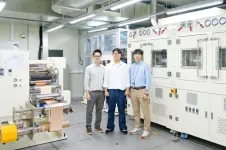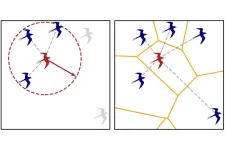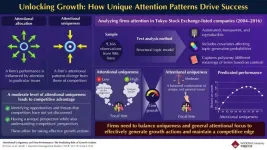(Press-News.org) WASHINGTON — Researchers have shown that a fluorescence detection system that doesn’t contain any lenses can provide highly sensitive detection of deadly microorganisms in drinking water. With further development, the new approach could provide a low-cost and easy-to-use way to monitor water quality in resource-limited settings such as developing countries or areas affected by disasters. It could also be useful when water safety results are needed quickly, such as for swimming events, a concern highlighted during the Paris Olympics.
“In developing countries, unsafe water sources are responsible for more than one million deaths each year,” said research team leader Ashim Dhakal from the Phutung Research Institute in Nepal. “We hope that our work will facilitate the development of simpler and cost-effective yet highly efficient sensing paradigms for drinking water, saving countless lives around the world.”
Current methods used to assess microbial contamination in water require culturing the water samples and then quantifying harmful bacteria. This can take over 18 hours, making it impractical when immediate confirmation of water safety is needed. This is also a key reason why water surveillance is ineffective in developing countries, where the required skilled human resources, infrastructure and reagents are not readily available.
In Optica, Optica Publishing Group’s journal for high-impact research, researchers from Phutung Research Institute, University of São Paulo in Brazil and University of York in the UK report that their new water monitoring fluorometer can detect fluorescent proteins from bacteria in water down to levels of less than one part per billion, without using any lenses. This sensitivity meets the World Health Organization’s criteria for detecting fecal contamination in drinking water.
“Today’s fluorometers typically use costly lenses that are made of specialty UV-transparent glass and require precise positioning,” said Dhakal. “We show that eliminating the lenses not only reduces the device cost, size and weight but also provides better performance given that we are not aiming for imaging here.”
Getting rid of the lenses
This research is part of a larger project funded in part by the Optica Foundation Challenge, awarded to Dhakal in 2022 to pilot a portable, low-cost and user-friendly instrument for real-time water quality assessment. During development, the researchers closely examined the fundamentals of optical signal generation in applications like water quality monitoring. They discovered that while optical lenses are commonly used in devices such as cameras, microscopes and telescopes, these optical components often reduce performance for practical situations that don’t require images.
“This was an important finding because lenses account for a significant share of the costs of optical systems and their bulk and weight make it difficult to create practical portable devices,” said Dhakal. “Our analysis revealed that using a light source, detectors and sample sizes that are all as large and as close to each other as possible produces a stronger signal, leading to better performance for water quality monitoring.”
Comparison with a lensed system
Based on their findings, the researchers designed a lensless fluorescence system using large (1-2 mm2) LEDs and detectors, which have recently become available in UV wavelengths. It works by using UV light to excite proteins from harmful microbes and then detecting the resulting fluorescence.
In addition to demonstrating the lensless system’s sensitivity, they also showed that it produced a fluorescence signal that is about double the strength of a lensed system. They found that the performance of the lensed system was limited by its numerical aperture, the use of larger sources and detectors and the finite imaging distance required between the components and the sample.
The researchers are now developing a pocket-sized version of the lensless fluorometers for field testing. They point out that the instrument must be shown to withstand the harsh environments found in multiple scenarios before being widely applied. They are also working to demonstrate that their approach meets the specificity requirements for detecting specific bacterial contamination by incorporating measurement of multiple parameters into the device.
“Our system is already highly useful because the sensitive and accurate measurement of concentration of bacterial proteins that it provides is directly related to efficiency of water treatment, the dose of disinfectants required for disinfection and the likelihood of bacterial proliferation in a recontamination event,” said Dhakal.
Paper: A Maharjan, P Waiba, S. Shrestha, R. Maharjan, A. Martin, K. Li, E. R. Martin, T. F. Krauss, A. Dhakal, “When a lensless fluorometer outperforms a lensed system,” 11, 8 (2024).
DOI: doi.org/10.1364/OPTICA.527289.
About Optica
Optica is an open-access journal dedicated to the rapid dissemination of high-impact peer-reviewed research across the entire spectrum of optics and photonics. Published monthly by Optica Publishing Group, the Journal provides a forum for pioneering research to be swiftly accessed by the international community, whether that research is theoretical or experimental, fundamental or applied. Optica maintains a distinguished editorial board of more than 60 associate editors from around the world and is overseen by Editor-in-Chief Prem Kumar, Northwestern University, USA. For more information, visit Optica.
About Optica Publishing Group
Optica Publishing Group is a division of Optica, Advancing Optics and Photonics Worldwide. It publishes the largest collection of peer-reviewed content in optics and photonics, including 18 prestigious journals, the society’s flagship member magazine, and papers from more than 835 conferences, including 6,500+ associated videos. With over 400,000 journal articles, conference papers and videos to search, discover and access, Optica Publishing Group represents the full range of research in the field from around the globe.
END
Lens-free fluorescence instrument detects deadly microorganisms in drinking water
New approach promises low-cost, real-time water quality monitoring for developing countries, disaster areas and rapid testing needs at events like the Paris Olympics
2024-08-08
ELSE PRESS RELEASES FROM THIS DATE:
Individualized cancer therapy demonstrates safety and sustained immune responses
2024-08-08
For decades, researchers have worked to develop therapies that can prime the immune system to recognize and attack proteins on the surface of tumor cells. However, success has been limited due to the technological challenge of engineering therapies that provide specific enough “training” to the immune system to identify a given patient’s neoantigens. Now, investigators from Massachusetts General Hospital (MGH), a founding member of the Mass General Brigham healthcare system, have evaluated an ...
Eating disorder risks elevated among women with PCOS
2024-08-08
WASHINGTON—Women with the common reproductive and metabolic condition polycystic ovary syndrome (PCOS) face a greater risk of developing bulimia, binge eating disorder and disordered eating, according to new research published in The Journal of Clinical Endocrinology & Metabolism.
PCOS affects roughly one in eight women. Women who have the condition face an increased risk of developing metabolic problems such as diabetes, reproductive issues such as infertility, and psychological issues including anxiety and depression.
Women are diagnosed when they have at least two of the three ...
The first universal principles for designing solid-state batteries developed by Korean researchers
2024-08-08
A Korean research team has presented the first universal design principles for solid-state batteries, signaling a paradigm shift in battery design research that previously lacked standard benchmarks.
Dr. Jinsoo Kim from the Ulsan Advanced Energy Technology R&D Center of the Korea Institute of Energy Research (KIER) and Professor Sung-Kyun Jung's research team from the Ulsan National Institute of Science and Technology (UNIST) have jointly developed a design principles and a versatile design toolkit for implementing high-energy-density solid-state batteries and have completed performance verification.
With ...
Alcohol use in older adults doubles risk of brain bleeds from falls
2024-08-08
Nationally, falls remain the leading cause of both fatal and non-fatal injuries in older adults and are the leading cause of traumatic brain injury. In 2021, falls led to the deaths of 36,500 older adults in the United States and 3,805 older Floridians. While some studies have hypothesized that alcohol use contributed to these outcomes, there are few studies which have examined this issue.
As such, little is known about the association between the frequency of alcohol use and the severity of injuries sustained after a fall in older adults. A study by Florida Atlantic University’s Schmidt College of Medicine and collaborators, is one of the first to examine the relationship ...
Insilico Medicine received IND approval and orphan drug designation from FDA for ISM6331, an AI-designed TEAD inhibitor targeting solid tumors and mesothelioma
2024-08-08
CAMBRIDGE, Mass., Aug 8, 2024 --- Insilico Medicine ("Insilico"), a clinical-stage generative artificial intelligence (AI)-driven biotechnology company, today announced ISM6331, potential best-in-class pan-TEAD inhibitor, has received the U.S. Food and Drug Administration (FDA) Investigational New Drug (IND) clearance for the treatment of mesothelioma, following the grant of Orphan Drug Designation (ODD) in June 2024. It brings the total number of IND-approved molecules of Insilico to nine.
Mesothelioma is a type of cancer that affects the mesothelium, a thin layer of tissue that covers most of the ...
Are birds flying atoms?
2024-08-08
A crowd or a flock of birds have different characteristics from those of atoms in a material, but when it comes to collective movement, the differences matter less than we might think. We can try to predict the behavior of humans, birds, or cells based on the same principles we use for particles. This is the finding of a new study published in the Journal of Statistical Mechanics: Theory and Experiment, JSTAT, conducted by an international team that includes the collaboration of MIT in Boston and CNRS in France. The study, based on the physics ...
New study is helping to understand and achieve species elements in the Kunming–Montreal Global Biodiversity Framework
2024-08-08
Experts provide clarity on key terms for urgent species recovery actions to support the implementation of the Global Biodiversity Framework.
The Kunming-Montreal Global Biodiversity Framework (KMGBF) is a landmark agreement ratified in 2022 by Parties to the Convention on Biological Diversity that outlines ambitious goals to combat biodiversity decline.
The Framework states outcomes for species to be achieved by 2050 in Goal A and establishes a range of targets to reduce pressures on biodiversity and halt biodiversity loss ...
Unlocking the secrets of salt stress tolerance in wild tomatoes
2024-08-08
As our climate changes and soil salinity increases in many agricultural areas, finding crops that can thrive in these challenging conditions is crucial. Cultivated tomatoes, while delicious, often struggle in salty soils. Their wild cousins, however, have evolved to survive in diverse and often harsh environments. A recent study delved into the genetic treasure trove of wild tomatoes to uncover secrets of salt tolerance that could be used to develop resilient crop varieties.
A team of researchers focused on Solanum pimpinellifolium, the closest wild relative of our beloved cultivated tomato. These tiny, ...
Detecting climate change using aerosols
2024-08-08
Climate change is one of the most significant environmental challenges of present times, leading to extreme weather events, including droughts, forest fires, and floods. The primary driver for climate change is the release of greenhouse gases into the atmosphere due to human activities, which trap heat and raise Earth’s temperature. Aerosols (such as particulate matter, PM2.5) not only affect public health but also influence the Earth's climate by absorbing and scattering sunlight and altering cloud properties. Although future climate change predictions are being reported, it is possible that the impacts of climate change could be more severe than predicted. ...
Exploring the impact of attentional uniqueness and attentional allocation on firm growth
2024-08-08
According to the attention-based view, a firm’s actions and growth performance are directly influenced by its attentional allocation to specific issues. The consequences of organizational attention are reflected in the firm’s strategic decision-making and adaptability. However, existing literature is limited in its exploration of how a firm’s attentional uniqueness impacts its behavior and performance. Notably, attentional uniqueness refers to how the firm’s attentional allocation diverges from competitors in the same industry.
To address the above-mentioned knowledge gap, Associate Professor Takumi ...
LAST 30 PRESS RELEASES:
The perfect plastic? Plant-based, fully saltwater degradable, zero microplastics
Bias in data may be blocking AI’s potential to combat antibiotic resistance
Article-level metrics would provide more recognition to most researchers than journal-level metrics
Satiety’s little helper: Protein that supports appetite regulating protein identified
UF dives deep into predicting storm damage with computer models
A stormy ocean voyage yields insights on the global carbon cycle
Scientists identify first non-coding gene that controls cell size
Demonstration of altermagnetism in RuO₂ thin films -- A new magnetic material for the AI era
Penn researchers awarded $25M to conduct trial using smartphones to fight heart disease
PCORI awards funding for new patient-centered healthcare research
Exploring the origins of the universe: 145 low-noise amplifiers complete ALMA telescopes
Empress cicada wings help illuminate molecular structure
Using sound waves to detect helium
Time burden in patients with metastatic breast and ovarian cancer from clinic and home demands
Researchers discover bias in AI models that analyze pathology samples
Scientists ID potential way to prevent brain injuries from triggering Alzheimer's
MASTER 2nd Open Call: Execution period kick-off
Algae for health in food and pharma
Advanced microrobots driven by acoustic and magnetic fields for biomedical applications
Chicago health information leader recognized for raising CPR readiness and blood pressure awareness
The Intimate Animal, a new book from Kinsey Institute Executive Director Dr. Justin Garcia
When blue-collar workers lose union protection, they try self-employment
New video dataset to advance AI for health care
MEA-based graph deviation network for early autism syndrome signatures in human forebrain organoids
New modeling approach sheds light on rare gut disease
Study documents potentially hazardous flame retardants in firefighter gear
Can certain bacteria regulate aging of the immune system and its related alterations?
AI model helps diagnose often undetected heart disease from simple EKG
There are fewer online trolls than people think
Cell membrane fluctuations produce electricity
[Press-News.org] Lens-free fluorescence instrument detects deadly microorganisms in drinking waterNew approach promises low-cost, real-time water quality monitoring for developing countries, disaster areas and rapid testing needs at events like the Paris Olympics






